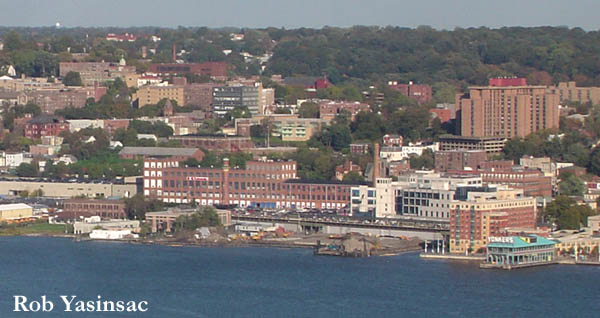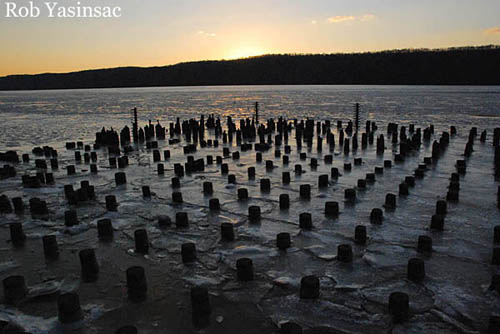
View from Alpine Lookout, Palisades Interstate Park, New Jersey. October 2006.

View from Alpine Lookout, Palisades
Interstate Park, New Jersey. October 2006.
A wide array of ruins and
other impressive historic architecture can be found in the City of Yonkers, which sits on
the Hudson River and shares New York City's northern border. Yonkers has its
roots among the commercial ventures of the Dutch settlers in the mid-1600s - the
name itself draws from one of the earliest local landowners, the "Jonkheer,"
Adriaen van der Donck - the Dutch colony's only lawyer. (Van der Donck's home
stood, however, in what is now Van Cortlandt Park in New York City.)
Yonkers is
currently embarking on perhaps the biggest revitalization effort among the
rivertowns. Although other cities have their histories of economic decline,
labor strife, poverty and other social distresses, few have had them as pronounced
as Yonkers. The push to build anew may threaten some of the city's historic
building stock.

The abandoned buildings here
(and ones occupied but converted from their original purposes), tell the story of a
city in search of its identity. It is a city marked by its divisions - geographic
and otherwise. Split in half by the river that sprouted mills in the colonial
period and onward, Yonkers has been very
urban place with numerous factories and commercial buildings It also has
rural pockets in the northern part of the city where some of the most grand
estates along the Hudson were established. And to the east
of the Saw Mill River are prominent suburban enclaves.
However, poverty reigns over corners of Yonkers as well, especially in the
southwestern part of the city. That it came to be this way is no accident
- Yonkers is still dealing with issues of black and white. As a United States
federal judge found, the city conspired to racially segregate its school system by constructing
public housing in only one part of town. Public housing mandates set by the
court in 1985 still affect municipal actions in 2007.
Yonkers has been plagued by economic downturns since local corporations
realized they could make more money by moving to other states where they could
pay lower wages and build new factories with public subsidies. That was the
1950s. Today, the city is banking on massive commercial redevelopment that
includes the construction of high-end condominiums on the old industrial
riverfront and a minor league baseball stadium with high-end retail and entertainment outlets
in the Getty Square commercial district - currently occupied by discount stores and fast food
restaurants that cater to the area's largely poor and elderly residents.
As the wheels of fortune spin, the ruins of Yonkers are
target for the wrecking ball. However, as things go, one force usually has an
opposite, and in Yonkers there are community activists who are working to see
the development is guided by the city, not that development dictates the city.
Hopefully, some of these architectural gems can be recognized for their value
to the community and be incorporated in to the future Yonkers.

Yonkers Photo Galleries of ruined and
not-so-ruined architecture:
Gallery
1 - Ashburton Avenue corridor.
Gallery 2
- Industrial Downtown: Woodworth Avenue, Buena Vista Avenue, and vicinity.
Gallery 3 - Commercial Downtown: Getty Square and vicinity.
Gallery
4 - The Estate District: North Broadway and Warburton Avenue.
Alexander
Smith and Sons Carpet Mills - One of the
best surviving mill districts, anywhere. Parts of this vast complex are
threatened by high-end redevelopment.
A few choice ruins and abandoned buildings in Yonkers:
Alder
Manor - Abandoned in the 1990s, the mansion is now
maintained and often is used in movie & television spots. An elegant
"ruined garden" adjoins the house.
Boyce
Thompson Institute for Plant Research - A vacant scientific research
facility, planned for redevelopment.
Mulford
Gardens - Yonkers' largest and Westchester's oldest public housing complex,
now vacant and soon to be demolished. Updated with two new pages of photos,
November 2009. Demolished, 2009.
Public
Bath Number 4 - National Register-listed site, to be demolished in early
2011.
Vineyard Avenue Fire Station #2 - Demolished June
2008.
Yonkers
Power Station - One of the premier industrial relics
in the Hudson Valley. (Popularly called the Glenwood Power Station.)
Yonkers
Teutonia - Social hall for a German singing and literary
association. Demolished 2014.

Dock ruins in front of the Scrimshaw
House, a power plant converted into an apartment building.
Sunset, February 2007.
This page copyright © 2007
by Robert J. Yasinsac.
Reproduction or copying of text and photography without permission of the author
is prohibited.